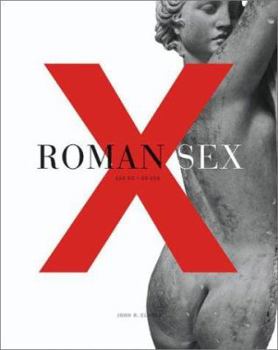Roman Sex: 100 B.C. to A.D. 250
Select Format
Select Condition 
Book Overview
Picture a world where good sex is a blessing of the gods, not a cause for guilt, and where acts often considered immoral, even illegal by our standards are instead celebrated. Such a world is no futurist's fantasy but rather the reality of ancient Rome, 100 BC to 250 AD. era, historian John R. Clarke exposes paintings, sculptures and ceramics featuring such controversial subject matter as group sex, lesbianism and the phallus as talisman. He then uses these works to explain ancient Roman attitudes towards a range of societal issues.
Format:Hardcover
Language:English
ISBN:0810942631
ISBN13:9780810942639
Release Date:April 2003
Publisher:Harry N. Abrams
Length:168 Pages
Weight:2.18 lbs.
Dimensions:0.8" x 8.8" x 11.0"
Grade Range:Grade 8 to Postsecondary
Customer Reviews
3 ratings
Enlightened
Published by Thriftbooks.com User , 17 years ago
What a great book. Things we should all know about the past, and not hide. I'm not in agreement with the slaves, but otherwise I think I could live in the Roman culture. What a pity we have been led to believe that sex is ... a sin,ugly, etc - Resist the evil forces that try to lead us, and try to conform us! We should be free ....
Roman Sexuality as Seen through Its Art.
Published by Thriftbooks.com User , 18 years ago
"Roman Sex" is a study and showcase of ancient Roman sexual practice as it was expressed in art 100 BC-250 AD. Issues related to sex, such as birth control, birth rates, or courting rituals are beyond the scope of this book. References to sex are plentiful in Roman literature, which was invariably written by elite males. Erotic art, on the other hand, adorned the homes and buildings of a broader swath of Roman society and therefore represented the attitudes of middle and working class Romans as well. There are about 100 beautifully reproduced photographs of erotic paintings, mosaics, sculpture, and ceramics in "Roman Sex", primarily from Rome, Pompeii, and Herculaneum. But this isn't just a "coffee table" production. Historian and author John Clarke takes care to place the art within its original context, most often in people's homes, and in so doing asks us to put aside the modern ideas of "pornography" and "hetero-" or "homosexuality" that are barriers to viewing sex as the Romans did. Sex in its many forms was a gift from the gods. And erotic art was part of the daily lives of many Romans. "Roman Sex" explores erotic art in the home, the sexual place of women, art in brothels and baths, the phallus as good luck talisman, and erotic art from Roman France. There is some exquisite art work on display in this book, as well as some paintings that are difficult to make out. The gestures and purposes of some pieces remain mysterious, and the rigid sexual hierarchy of Rome's elite makes for some amusing scenes. But we have the benefit of Clarke's scholarship in deciphering what it all meant to the Romans. "Roman Sex" provides a window on the erotic lives and values of Romans through their beautiful art.
fine assessments
Published by Thriftbooks.com User , 22 years ago
The greatest injustice a potential reader of this book could commit would be to see it as merely a handsomely illustrated presentation volume. As John R. Clarke writes in the introduction to this work, it presents a more adequate synthesis and overview of the findings and researches he has pursued on Roman sexuality over the last two decades or so. The essay, a series of discrete chapters, reveals the finest descriptions of Roman sexuality informed by the analysis of ceramic, fresco, and engraved art. Most clever about Clarke's approach, similar in this respect to his earlier, more site-specific work, is the emphasis put on the interpretation of the artworks by recreating what Roman viewers would look for and find. Roman taboo and Roman prescriptions for the realm of sex differ profoundly from ours and Clarke explicitly draws the distinctions. He explains the narratives on the Roman walls with convincing acuity.Images from Pompeii figure prominently here. Still, the author has also sought out and discusses more recent findings from Roman France as well as special items that seem finally ready to be shared by their keepers in private collections and museum holding rooms in Switzerland.Clarke imaginatively and convincingly tries to set the images and objects of art into their original contexts. For example, the images of the Suburban Baths at Pompeii according to the author depict positions and situations that would induce laughter from Roman bathers, male and female alike, thus warding off the evil eye. I am not convinced that a frequent bather would continue to find the same fresco images comical and therefore a protection, but Clarke's understanding of Roman sexuality is stunning and gracefully communicated.For those who wish to read a beautiful exposition of Roman intimate pursuits and daily encounters with the erotic, I recommend this book highly.






